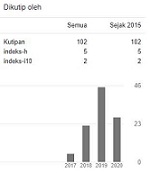THE IMPLEMENTATION OF RECIPROCAL TEACHING METHOD TO THE STUDENTS’ READING COMPREHENSION ON THE ELEVEN GRADES OF IPA 1 AT SMA MUHAMMADIYAH PAMEKASAN
Abstract
Many techniques can be applied to solve the problems above, including Reciprocal Teaching Method because many research findings say that this technique is effective to the students’ reading comprehension. In this research, the researcher located at SMA Muhammadiyah Pamekasan. The approach of this reasearch is qualitative and the data are gotten by observation, interview and documentation. Then, those data are analyzed with analysis qualitative- descriptive and all of data gotten are checked the validity of the data. Reciprocal teaching refers to an instructional activity in which students become the teacher in small group reading sessions. Teachers model, then help students learn to guide group discussions using four strategies: Predicting, Questioning, Clarifying and Summarizing. Reciprocal teaching is most effective in the context of small-group collaborative investigation, which is maintained by the teacher or reading tutor. The objectives of the study are (1) the researcher wanted to describe how the teacher implement reciprocal teaching method to the students’ reading comprehension on the eleven grades of IPA 1 at SMA Muhammadiyah Pamekasan is. (2) And the researcher wanted to figure out the students’ responses in studying reading by reciprocal teaching method. The result of the research shows that (1) The teacher implemented the reciprocal teaching well in the teaching and learning process. The teacher divided the class into five groups and gave the students worksheet, the teacher gave the students an analytical exposition text and asked them to do worksheet with their group, the teacher pointed the students one by one to read the result of the discussion and the teacher discuss together with the students about the material and giving the conclusions. (2) The reciprocal teaching method is able to make the students having more spirits to read and study reading comprehension because reciprocal teaching is an effective method to make the class more interesting. The result of the last research is questionnaire for the learners. Most of the learners were happy to study reading by using reciprocal teaching method.
Keywords
References
Allen, S. (2003). An analytic comparison of three models of reading strategy instruction. IRAL: International Review of Applied Linguistics in Language Teaching. 41(4), 319-339.
Ary, Donal et all. 1979. Introduction to Research in Education. Newyork: holt, Rinehart and Winston.
Bodgan C. Robert, 1998. Qualitative Research for Education. University of America.
Doolittle, P.E., Hicks,D., Triplett, C.F., Nichols, W.D., & Young, C.A.(2006). Reciprocal teaching for reading comprehension in higher education: A strategy for fostering the deeper understanding of text. International Journal of Teaching and Learning in Higher Education. 17 (2), 106-118.
Hashey, J. M, & Connors, D. J. (2003). Learn from our journey: Reciprocal teaching action research. Reading Teacher, 57(3), 224-233.
Oczkus, L. (2003). Reciprocal teaching at work: strategies for improving reading comprehension. Newark, DE: International Reading Association
Oxford, 2003. Oxford Learners’ Pocket Dictionary (Third Edition) Newyork: Oxford University Press.
Palincsar, A.S. (1986). Reciprocl teaching. In Teaching reading as thinking. Oak Brook, IL: North Central Regional Educational Laboratory.
Palincsar, A. S., & Brown, A. L. (1984). Reciprocal teaching of comprehension-fostering and comprehension-monitoring activities. Cognition and Instruction, 2, 117-175.
Palincsar, A. S., & Brown, A. L. (1986). Interactive teaching to promote independent learning from text. The Reading Teacher, 39(8), 771-77.
Rosenshine, B. & Meister, C. (1994). Reciprocal Teaching: A review of the research. Review of Educational Research. 64(4)479-530.
Slater, W. H., & Horstman, F.R. (2002). Teaching reading and writing to struggling middle school and high school students: The case for reciprocal teaching. Preventing School Failure, 46 (4), 163.
DOI: 10.53712/ellite.v1i1.527
Refbacks
- There are currently no refbacks.







